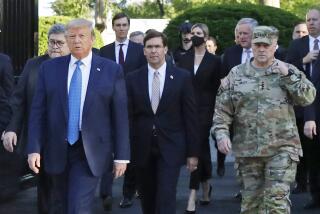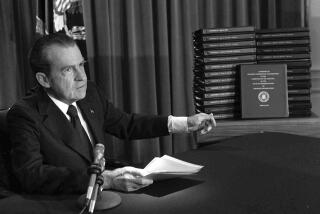Overspending the peace dividend
In unveiling a new strategic review Thursday, President Obama warned that “we can’t afford to repeat the mistakes that have been made in the past — after World War II, after Vietnam — when our military was left ill-prepared for the future.”
“As commander in chief,” he vowed, “I will not let that happen again. Not on my watch.”
Actually, it is already happening again on his watch. Last summer, defense spending was slashed by $487 billion over 10 years. Then, right before Thanksgiving, a special committee of Congress failed to agree on $1.2 trillion in alternative cuts, which opened the way to another $500 billion or so in defense cuts. Hundreds of billions more in so-called emergency funding will be gone as we wind down operations in Iraq and Afghanistan. In all, the defense budget could shrink by 31% over the next decade, according to the Center for Strategic and Budgetary Assessments. That compares with cuts of 53% after the Korean War, 26% after the Vietnam War and 34% after the Cold War.
Some might argue that there is nothing wrong or damaging in this; that we always downsize our military after the conclusion of hostilities. But is it so wise to repeat history? Leave aside the fact that we are not really at peace — troops are in combat every day in Afghanistan — and simply consider the consequences of past drawdowns.
After the American Revolution, the military plummeted from 35,000 men in 1778 to 10,000 by 1800. As a result, the nascent republic had to scramble to put down the Whiskey Rebellion, fight a quasi-war with France, repress the Barbary pirates and, most spectacularly, defend the new national capital from British attack in the War of 1812. The burning of the White House stands as melancholy testimony to our military unpreparedness.
Yet we made the same mistake after the Civil War. The armed forces fell from more than 1 million men in 1865 to merely 50,000 in 1870. Luckily we did not face a foreign attack in the postwar decades. But we did face the challenge of Reconstruction. Its failure was made inevitable by Washington’s inability (or unwillingness) to station enough federal troops in the South to repress the Ku Klux Klan. By 1876, all federal troops were withdrawn and the era of Jim Crow had begun.
If we discount the small-scale Indian Wars (the main focus of the U.S. Army from 1865 to 1890), the next major conflicts we faced were the Spanish-American and Philippine wars. Our army, which in the late 19th century numbered only 25,000 men — smaller than today’s New York Police Department — was unready for both conflicts but did not pay too high a price for that because of the poor condition of its enemies (the decrepit Spanish army and the meagerly armed Filipino insurrectos).
The costs of our unreadiness for the Great War were also somewhat masked, this time by the veteran armies of our allies, Britain and France, which provided on-the-job training for American doughboys. But after World War I, both Britain and France were so drained that they could not police a fragile peace. And neither could we — not as our armed forces shrank from 2.9 million in 1918 to 250,000 in 1928. Our abdication of leadership made a second world war more likely and, when it came, practically guaranteed that we and our allies would lose the early battles.
With those lessons fresh in their minds, American statesmen in the late 1940s were determined to maintain a presence in Europe after World War II. Still, they demobilized so rapidly that the armed forces shrank from a wartime high of 12 million to 1.4 million by 1950. Not coincidentally, that was the year that Kim Il Sung invaded South Korea, confident that American armed forces would not stand in his way. Eventually the U.S. recovered half the peninsula, but only at the cost of 36,000 dead Americans.
The decline in the size of the armed forces after the Korean War was less drastic than after World War II (from 3.6 million men in 1952 to 2.5 million in 1959), but the army still lost almost half its active-duty strength in the 1950s. President Eisenhower was enamored of a New Look strategy that sought to minimize conventional forces in favor of nuclear forces. That may have sufficed to deter a Red army invasion of Western Europe, but it did nothing to prevent the Soviet Union and China from pursuing proxy wars against the U.S., most successfully in Vietnam. This was not a conflict we were well prepared for, and we paid a high price because of it.
The 1970s saw yet another massive drawdown, with the military falling from 3.5 million in 1969 to 2 million in 1979. Drug use, racial tension, insubordination, even “fragging” (soldiers attacking officers) were hallmarks of this era, which culminated in a hollow army that could not deter the Soviet Union from invading Afghanistan or rescue the American hostages in Iran.
The Reagan defense buildup of the 1980s, which actually began under Jimmy Carter, rescued the military from the doldrums of the 1970s and created the force that won the Persian Gulf War. But then, after Desert Storm and the end of the Cold War, the George H.W. Bush and Clinton administrations rushed to spend the “peace dividend.” The military shrank from 2.1 million active-duty personnel in 1989 to 1.3 million in 1999. The Army was particularly hard hit: It shrank from 769,000 to 479,000 soldiers.
The “end of history” reverie ended in 2001, but even after Sept. 11, the Army was too small to fight in both Iraq and Afghanistan. We are still paying a price for not sending enough troops to pacify both countries after we toppled their regimes. Partly this was a miscalculation on the part of Bush administration officials who thought that U.S. troops would do more harm than good. A calculation itself was driven by the paucity of available troops.
Now we are repeating that very mistake. The army will reportedly shrink from its current strength of 569,000 to just 490,000. Those who advocate such cuts claim that, after the wars in Afghanistan and Iraq, we will never have to fight another major ground war again — and certainly not two at the same time.
Haven’t we heard that before?
Max Boot is a contributing editor to Opinion and a senior fellow at the Council on Foreign Relations. This essay is adapted from an article in the current issue of Commentary.
More to Read
A cure for the common opinion
Get thought-provoking perspectives with our weekly newsletter.
You may occasionally receive promotional content from the Los Angeles Times.










